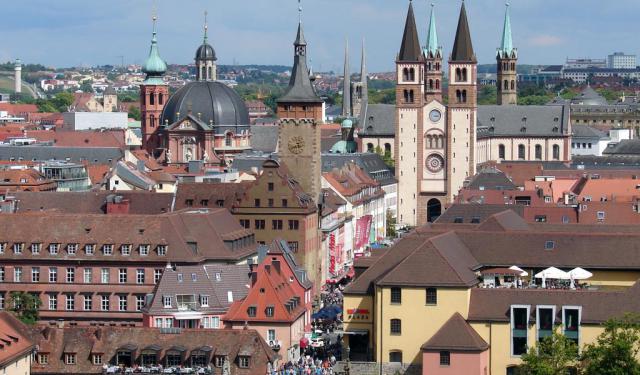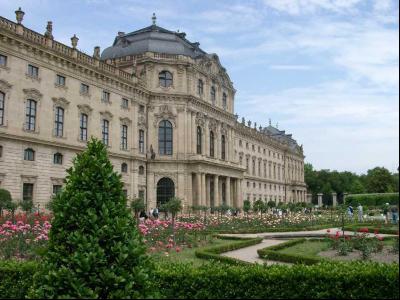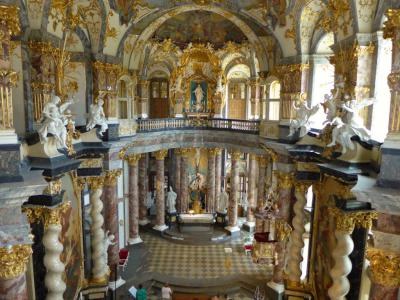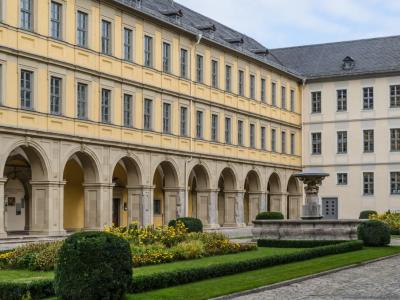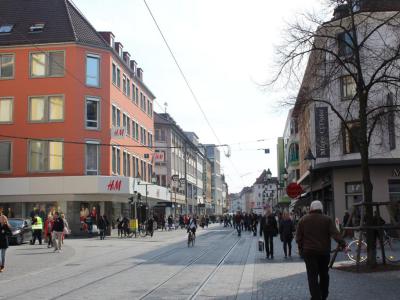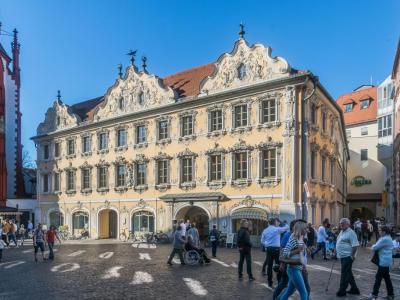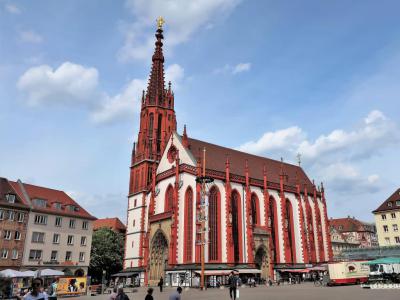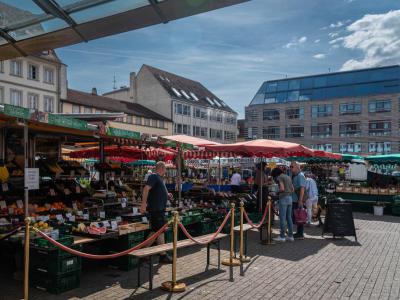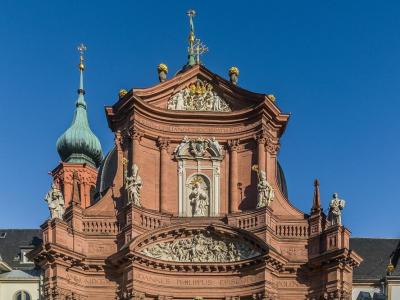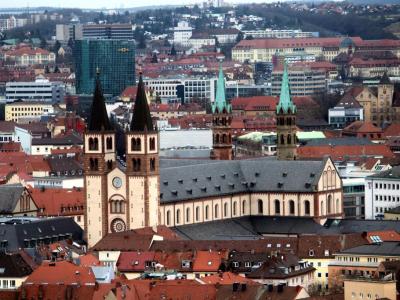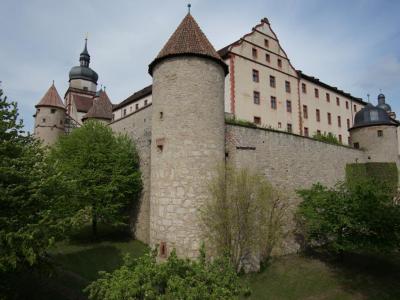Wurzburg Introduction Walking Tour (Self Guided), Wurzburg
The old Franconian episcopal city and university town of Würzburg in the German state of Bavaria boasts a history dating back to the Bronze Age. Originally, the Leistenberg hill presently occupied by Marienberg Fortress was home to a Celtic and later a Roman fort. In the 4th-5th centuries AD, Alamanni settled in the area, followed by the Franks in the 6th-7th centuries.
By 650, Würzburg had become the seat of a Merovingian duke and was Christianized in 686 by Irish missionaries. Mentioned in historical records as "Virteburch" in 704 and "Uburzis" in the Ravenna Cosmography, the city's name likely has Celtic origins. Based on a folk etymological connection to the German word Würze which means "herb, spice", it was Latinized as Herbipolis during the medieval period.
In 742, Saint Boniface founded the first diocese in the city. Würzburg witnessed Imperial Diets and conflicts, like the Battle of Bergtheim in 1400 and the German Peasants' War in 1525. It also saw the Würzburg witch trials between 1626 and 1631.
During World War II, the city suffered extensive damage in a March 1945 British air raid, destroying over 90% of its architecture. Remarkably, post-war reconstruction was carried out mainly by the so-called "rubble women". Nowadays, a fascinating display about the bombing, marked each year by the rising of the city's church bells, can be seen in the Old Town Hall.
One of Würzburg's most iconic landmarks is the Würzburg Residence (Würzburg Residenz), a UNESCO World Heritage Site, showcasing the opulence of the Baroque era.
Religious landmarks abound in Würzburg too, including the Saint Mary's Chapel (Marienkapelle), the Neumünster Collegiate Church, and the Würzburg Cathedral (Würzburger Dom). These sacred sites offer not only spiritual solace but are also architectural marvels.
The heart of the city beats at the Market Square (Marktplatz), where locals and visitors gather to enjoy the vibrant atmosphere. Strolling along the Old Main Bridge (Alte Mainbruecke), a popular spot for romantic walks, offers stunning views of the city.
Lastly, Marienberg Fortress, perched high above the city, provides a glimpse into its military history complete with panoramic views fit to leave anyone breathless.
Despite its turbulent history, Würzburg has risen from the ashes, showcasing its resilience and enduring cultural heritage. Today, it stands as a testament to the indomitable spirit of its people. So, embark on a journey to this enchanting city and let its historical sites and warm hospitality leave an indelible mark on your heart.
By 650, Würzburg had become the seat of a Merovingian duke and was Christianized in 686 by Irish missionaries. Mentioned in historical records as "Virteburch" in 704 and "Uburzis" in the Ravenna Cosmography, the city's name likely has Celtic origins. Based on a folk etymological connection to the German word Würze which means "herb, spice", it was Latinized as Herbipolis during the medieval period.
In 742, Saint Boniface founded the first diocese in the city. Würzburg witnessed Imperial Diets and conflicts, like the Battle of Bergtheim in 1400 and the German Peasants' War in 1525. It also saw the Würzburg witch trials between 1626 and 1631.
During World War II, the city suffered extensive damage in a March 1945 British air raid, destroying over 90% of its architecture. Remarkably, post-war reconstruction was carried out mainly by the so-called "rubble women". Nowadays, a fascinating display about the bombing, marked each year by the rising of the city's church bells, can be seen in the Old Town Hall.
One of Würzburg's most iconic landmarks is the Würzburg Residence (Würzburg Residenz), a UNESCO World Heritage Site, showcasing the opulence of the Baroque era.
Religious landmarks abound in Würzburg too, including the Saint Mary's Chapel (Marienkapelle), the Neumünster Collegiate Church, and the Würzburg Cathedral (Würzburger Dom). These sacred sites offer not only spiritual solace but are also architectural marvels.
The heart of the city beats at the Market Square (Marktplatz), where locals and visitors gather to enjoy the vibrant atmosphere. Strolling along the Old Main Bridge (Alte Mainbruecke), a popular spot for romantic walks, offers stunning views of the city.
Lastly, Marienberg Fortress, perched high above the city, provides a glimpse into its military history complete with panoramic views fit to leave anyone breathless.
Despite its turbulent history, Würzburg has risen from the ashes, showcasing its resilience and enduring cultural heritage. Today, it stands as a testament to the indomitable spirit of its people. So, embark on a journey to this enchanting city and let its historical sites and warm hospitality leave an indelible mark on your heart.
How it works: Download the app "GPSmyCity: Walks in 1K+ Cities" from Apple App Store or Google Play Store to your mobile phone or tablet. The app turns your mobile device into a personal tour guide and its built-in GPS navigation functions guide you from one tour stop to next. The app works offline, so no data plan is needed when traveling abroad.
Wurzburg Introduction Walking Tour Map
Guide Name: Wurzburg Introduction Walking Tour
Guide Location: Germany » Wurzburg (See other walking tours in Wurzburg)
Guide Type: Self-guided Walking Tour (Sightseeing)
# of Attractions: 11
Tour Duration: 2 Hour(s)
Travel Distance: 3.0 Km or 1.9 Miles
Author: DanaOffice
Sight(s) Featured in This Guide:
Guide Location: Germany » Wurzburg (See other walking tours in Wurzburg)
Guide Type: Self-guided Walking Tour (Sightseeing)
# of Attractions: 11
Tour Duration: 2 Hour(s)
Travel Distance: 3.0 Km or 1.9 Miles
Author: DanaOffice
Sight(s) Featured in This Guide:
- Wurzburg Residenz (Wurzburg Residence)
- Hofkirche (Court Church)
- Stiftung Juliusspital (Julius Hospital)
- Schonbornstrasse (Schonborn Street)
- Falkenhaus (House to the Falcon)
- Marienkapelle (St. Mary's Chapel)
- Marktplatz (Market Square)
- Neumunster Kirche (Neumunster Church)
- Wurzburger Dom (Wurzburg Cathedral)
- Alte Mainbruecke (Old Main Bridge)
- Festung Marienberg (Marienberg Fortress)
1) Wurzburg Residenz (Wurzburg Residence) (must see)
The Würzburg Residence in Würzburg was primarily used as the official residence of the Prince-Bishops of Würzburg. These Prince-Bishops were high-ranking ecclesiastical and secular authorities who ruled over the Prince-Bishopric of Würzburg, a territory in the Holy Roman Empire.
The Würzburg Residence was constructed in the 18th century, primarily between 1720 and 1744, under the patronage of Johann Philipp Franz von Schönborn, the Prince-Bishop of Würzburg. It was designed by the renowned architect Balthasar Neumann, who played a crucial role in its construction.
The palace is celebrated for its remarkable Baroque architecture, characterized by its symmetrical layout, intricate stucco work, and grandeur. The most iconic feature of the Würzburg Residence is its magnificent staircase, known as the "Treppenhaus," which is considered a masterpiece of Baroque architecture. The staircase features a stunning fresco by the Venetian artist Giovanni Battista Tiepolo, depicting the four continents: Europe, America, Asia, and Africa.
The interior of the Würzburg Residence is equally impressive, boasting lavishly decorated rooms and halls. Visitors can explore various chambers, including the White Hall, the Imperial Hall, and the Mirror Cabinet, each adorned with ornate frescoes, gilded decorations, and fine furnishings. The Mirror Cabinet, in particular, is famous for its intricate mirrors, crystal chandeliers, and precious decorations.
In 1981, the Würzburg Residence was designated as a UNESCO World Heritage Site, recognizing its cultural and historical significance as a prime example of Baroque architecture in Germany.
Surrounding the palace, you'll find beautifully landscaped gardens and courtyards, which add to the overall charm of the Würzburg Residence. The Hofgarten (Court Garden) features terraced gardens, fountains, and sculptures, making it a pleasant place for a leisurely stroll.
Today, the Würzburg Residence is open to the public, allowing visitors to explore its magnificent rooms, art collections, and the stunning Tiepolo frescoes. Guided tours are available to provide insights into the history and architectural significance of the palace.
The Würzburg Residence was constructed in the 18th century, primarily between 1720 and 1744, under the patronage of Johann Philipp Franz von Schönborn, the Prince-Bishop of Würzburg. It was designed by the renowned architect Balthasar Neumann, who played a crucial role in its construction.
The palace is celebrated for its remarkable Baroque architecture, characterized by its symmetrical layout, intricate stucco work, and grandeur. The most iconic feature of the Würzburg Residence is its magnificent staircase, known as the "Treppenhaus," which is considered a masterpiece of Baroque architecture. The staircase features a stunning fresco by the Venetian artist Giovanni Battista Tiepolo, depicting the four continents: Europe, America, Asia, and Africa.
The interior of the Würzburg Residence is equally impressive, boasting lavishly decorated rooms and halls. Visitors can explore various chambers, including the White Hall, the Imperial Hall, and the Mirror Cabinet, each adorned with ornate frescoes, gilded decorations, and fine furnishings. The Mirror Cabinet, in particular, is famous for its intricate mirrors, crystal chandeliers, and precious decorations.
In 1981, the Würzburg Residence was designated as a UNESCO World Heritage Site, recognizing its cultural and historical significance as a prime example of Baroque architecture in Germany.
Surrounding the palace, you'll find beautifully landscaped gardens and courtyards, which add to the overall charm of the Würzburg Residence. The Hofgarten (Court Garden) features terraced gardens, fountains, and sculptures, making it a pleasant place for a leisurely stroll.
Today, the Würzburg Residence is open to the public, allowing visitors to explore its magnificent rooms, art collections, and the stunning Tiepolo frescoes. Guided tours are available to provide insights into the history and architectural significance of the palace.
2) Hofkirche (Court Church)
The Court Church, a splendid gem within Würzburg's Residenz, stands as a testament to the architectural prowess of its time. Erected between 1732 and 1743, the church's creation was spurred by the vision of Prince-Bishop Johann Philipp Franz von Schönborn, with the artistic guidance of Balthasar Neumann.
Facing the challenge of integrating the church into the southwest corner of the residence while maintaining architectural harmony, Neumann ingeniously employed mirrors on the windowless side to mimic the appearance of windows. The church's interior, a masterful creation, features a captivating play of dark pink and gold tones, adorned with stucco marble decorations resembling columns.
The floor plan reveals three consecutive oval rotundas, perceptible on the domes but subtly incorporated into the overall design. Neumann strategically used columns to break the narrow length of the room, enhancing its visual appeal. The maximum vault height of the Hofkirche reaches an impressive 18.90 meters.
The renowned artist Tiepolo, during his tenure in Würzburg, contributed to the church's splendor by painting the side altars. The right altarpiece depicts the Assumption of Mary, while the left portrays the fall of the angel Lucifer. These oil paintings are flanked by exquisite marble sculptures crafted by Johann Wolfgang van der Auwera, depicting figures like Empress Kunigunde, Emperor Henry II, the archangel Gabriel, and the guardian angel Raphael.
The main altar, adorned with marble sculptures by Auwera representing Saint Kilian and Burkard, is complemented by a poignant work by Antonio Bossi. Above the main altar, Bossi's stucco figures, including Caritas, Prudentia, Spes, and Fides, create a celestial ensemble. The upper altar, directly accessible from the prince-bishop's apartment, features Mary standing on the globe, symbolically triumphing over the snake amid a blue starry sky.
Materno Bossi's early classicist pulpit adds another layer of artistry, with four heads representing the continents, symbolizing the global reach of the proclaimed word of God. The Court Church's interior is a collaborative masterpiece, with Bossi and Johann Rudolf Byss playing pivotal roles in its design and adornment. The pulpit, stucco figures, and ceiling paintings collectively contribute to the church's unique and awe-inspiring ambiance, making it a captivating destination for both religious and artistic appreciation.
Facing the challenge of integrating the church into the southwest corner of the residence while maintaining architectural harmony, Neumann ingeniously employed mirrors on the windowless side to mimic the appearance of windows. The church's interior, a masterful creation, features a captivating play of dark pink and gold tones, adorned with stucco marble decorations resembling columns.
The floor plan reveals three consecutive oval rotundas, perceptible on the domes but subtly incorporated into the overall design. Neumann strategically used columns to break the narrow length of the room, enhancing its visual appeal. The maximum vault height of the Hofkirche reaches an impressive 18.90 meters.
The renowned artist Tiepolo, during his tenure in Würzburg, contributed to the church's splendor by painting the side altars. The right altarpiece depicts the Assumption of Mary, while the left portrays the fall of the angel Lucifer. These oil paintings are flanked by exquisite marble sculptures crafted by Johann Wolfgang van der Auwera, depicting figures like Empress Kunigunde, Emperor Henry II, the archangel Gabriel, and the guardian angel Raphael.
The main altar, adorned with marble sculptures by Auwera representing Saint Kilian and Burkard, is complemented by a poignant work by Antonio Bossi. Above the main altar, Bossi's stucco figures, including Caritas, Prudentia, Spes, and Fides, create a celestial ensemble. The upper altar, directly accessible from the prince-bishop's apartment, features Mary standing on the globe, symbolically triumphing over the snake amid a blue starry sky.
Materno Bossi's early classicist pulpit adds another layer of artistry, with four heads representing the continents, symbolizing the global reach of the proclaimed word of God. The Court Church's interior is a collaborative masterpiece, with Bossi and Johann Rudolf Byss playing pivotal roles in its design and adornment. The pulpit, stucco figures, and ceiling paintings collectively contribute to the church's unique and awe-inspiring ambiance, making it a captivating destination for both religious and artistic appreciation.
3) Stiftung Juliusspital (Julius Hospital)
Founded in 1576 by Julius Echter von Mespelbrunn, the Prince-Bishop of Würzburg, the Julius Hospital is a distinguished foundation in Germany encompassing the renowned hospital and winery. The establishment holds historical significance as it emerged on the grounds of a former Jewish cemetery, endowed with the abandoned Monastery of Sancta Vallis in Heiligenthal.
Originally conceived as a hospital, the Julius Hospital opened its doors in 1576. Beyond its medical services, the hospital initially welcomed pilgrims, individuals suffering from epilepsy, and orphaned children. The architectural ensemble of Julius Hospital reflects Baroque elegance, featuring a courtyard and a church that trace back to its inception. Notably, the northern wing, an impressive 160 meters in length, was an augmentation by Antonio Petrini in 1700–4, complemented by an extensive wine cellar beneath.
The Rococo pharmacy, a distinctive feature of v, remarkably withstood the bombing of 1945, preserving its historical charm. Adjacent to the hospital, the Alte Anatomie, constructed by Joseph Greising between 1705 and 1714, served as a hub for medical education. Renovated in 1788, it accommodated renowned medical figures like Albert von Kölliker, von Siebold, and Rudolf Virchow, instructing up to 48 students in surgery and anatomy.
The hospital's surroundings include a park utilized by patients, featuring a water basin adorned with stone dolphins and allegorical figures representing the Franconian rivers Main, Tauber, Saale, and Sinn. The park proudly displays the coat-of-arms of Johann Philipp von Greifenclau zu Vollraths, adding an aristocratic touch to the serene landscape.
With meticulous maintenance and modern amenities, including a new pipe organ installed by Orgelbau Vleugels in 2005, Juliusspital continues its legacy as a functional hospital and retirement home. Beyond its healthcare role, it boasts a notable viticultural distinction, standing as the second-largest winery in Germany and the most extensive individual German wine grower, cultivating an expansive 177 hectares of vineyards.
Originally conceived as a hospital, the Julius Hospital opened its doors in 1576. Beyond its medical services, the hospital initially welcomed pilgrims, individuals suffering from epilepsy, and orphaned children. The architectural ensemble of Julius Hospital reflects Baroque elegance, featuring a courtyard and a church that trace back to its inception. Notably, the northern wing, an impressive 160 meters in length, was an augmentation by Antonio Petrini in 1700–4, complemented by an extensive wine cellar beneath.
The Rococo pharmacy, a distinctive feature of v, remarkably withstood the bombing of 1945, preserving its historical charm. Adjacent to the hospital, the Alte Anatomie, constructed by Joseph Greising between 1705 and 1714, served as a hub for medical education. Renovated in 1788, it accommodated renowned medical figures like Albert von Kölliker, von Siebold, and Rudolf Virchow, instructing up to 48 students in surgery and anatomy.
The hospital's surroundings include a park utilized by patients, featuring a water basin adorned with stone dolphins and allegorical figures representing the Franconian rivers Main, Tauber, Saale, and Sinn. The park proudly displays the coat-of-arms of Johann Philipp von Greifenclau zu Vollraths, adding an aristocratic touch to the serene landscape.
With meticulous maintenance and modern amenities, including a new pipe organ installed by Orgelbau Vleugels in 2005, Juliusspital continues its legacy as a functional hospital and retirement home. Beyond its healthcare role, it boasts a notable viticultural distinction, standing as the second-largest winery in Germany and the most extensive individual German wine grower, cultivating an expansive 177 hectares of vineyards.
4) Schonbornstrasse (Schonborn Street)
Schönborn Street is a picturesque and historically significant street renowned for its rich history. The architectural beauty and vibrant atmosphere are making it a popular destination for both tourists and locals alike. The street has witnessed centuries of urban development, making it an important part of Würzburg's cultural heritage.
The street is home to a variety of shops, boutiques, and quaint cafes and restaurants. Visitors can explore the unique boutiques selling clothing, jewelry, antiques, and other artisanal goods. Additionally, there are numerous cafes and eateries where you can enjoy traditional German cuisine or simply relax with a coffee while taking in the street's ambiance.
Schönborn Street comes alive during festivals and special events. Whether it's during the Würzburg Wine Festival, Christmas markets, or other local celebrations, the street is often adorned with colorful decorations and bustling with activity.
The street is conveniently located in the heart of Würzburg, making it an ideal starting point for exploring the city's other attractions. Just a short walk away is the stunning Würzburg Residence (Würzburger Residenz), a UNESCO World Heritage site known for its opulent architecture and beautiful gardens. It's a pedestrian-friendly street, making it a pleasant place to stroll and soak in the atmosphere.
The street is home to a variety of shops, boutiques, and quaint cafes and restaurants. Visitors can explore the unique boutiques selling clothing, jewelry, antiques, and other artisanal goods. Additionally, there are numerous cafes and eateries where you can enjoy traditional German cuisine or simply relax with a coffee while taking in the street's ambiance.
Schönborn Street comes alive during festivals and special events. Whether it's during the Würzburg Wine Festival, Christmas markets, or other local celebrations, the street is often adorned with colorful decorations and bustling with activity.
The street is conveniently located in the heart of Würzburg, making it an ideal starting point for exploring the city's other attractions. Just a short walk away is the stunning Würzburg Residence (Würzburger Residenz), a UNESCO World Heritage site known for its opulent architecture and beautiful gardens. It's a pedestrian-friendly street, making it a pleasant place to stroll and soak in the atmosphere.
5) Falkenhaus (House to the Falcon)
The House to the Falcon is a prominent building located on the market square.The building served as the residence for the cathedral priest from 1338. In 1735, the property was acquired by Franz Thomas Meißner, an innkeeper, and was subsequently operated as the "Zum Falken" inn. In 1751, the widow of Meißner commissioned the construction of the three-gabled, stucco-decorated Rococo facade that adorns the building to this day. Throughout the 19th century, the House to the Falcon functioned as Würzburg's sole venue for concerts and dances.
Tragically, during World War II, the House to the Falcon was completely destroyed in a bombing raid on March 16, 1945, resulting in the collapse of parts of its facade. Recognizing its historical significance, the city of Würzburg purchased the property in 1939. The reconstruction of the facade was initially delayed, but in 1947, Rudolf Schlick, the Würzburg government architect, supported its restoration for reasons of monument preservation. The reconstruction, carried out in the early 1950s by the Würzburg municipal building authority based on old photographs, is considered exemplary according to the Dehio art manual. However, the internal organization of the building was adapted to contemporary purposes.
Since 1952, the House to the Falcon has housed the tourist information center and the central city library of Würzburg. Discussions in later decades considered incorporating the building into a department store complex, but preserving the recreated Rococo facade was a priority. In 1993, the city library in the House to the Falcon underwent reconstruction and expansion. The Falkenhof, which had served as a youth center since 1972, and the former Falken or central halls accessible via Marienplatz were demolished during this period.
Tragically, during World War II, the House to the Falcon was completely destroyed in a bombing raid on March 16, 1945, resulting in the collapse of parts of its facade. Recognizing its historical significance, the city of Würzburg purchased the property in 1939. The reconstruction of the facade was initially delayed, but in 1947, Rudolf Schlick, the Würzburg government architect, supported its restoration for reasons of monument preservation. The reconstruction, carried out in the early 1950s by the Würzburg municipal building authority based on old photographs, is considered exemplary according to the Dehio art manual. However, the internal organization of the building was adapted to contemporary purposes.
Since 1952, the House to the Falcon has housed the tourist information center and the central city library of Würzburg. Discussions in later decades considered incorporating the building into a department store complex, but preserving the recreated Rococo facade was a priority. In 1993, the city library in the House to the Falcon underwent reconstruction and expansion. The Falkenhof, which had served as a youth center since 1972, and the former Falken or central halls accessible via Marienplatz were demolished during this period.
6) Marienkapelle (St. Mary's Chapel)
Saint Mary's Chapel graces the Market Square as a splendid example of Gothic architecture dating back to the 14th century. Despite its sizable presence, the chapel holds the status of a chapel, lacking a parish of its own.
This Gothic gem, like many structures in Würzburg, faced significant damage during the Bombing of Würzburg in World War II. Flames devoured its interior, prompting extensive reconstruction efforts in the 1950s. The chapel was ultimately re-consecrated in 1962, reclaiming its role as a spiritual and cultural landmark.
Among its notable features, Saint Mary's Chapel housed two renowned sculptures by Tilman Riemenschneider, depicting Adam and Eve. Although these masterpieces now reside in the Mainfränkisches Museum, faithful reproductions have taken their place within the chapel. The church also serves as the final resting place of the esteemed Baroque architect Balthasar Neumann.
Architecturally, Saint Mary's Chapel presents a captivating fusion of a basilica and a hall church, a style prevalent in late-Gothic design. Its three aisles and five bays, with the middle aisle only slightly elevated, create a harmonious spatial arrangement. Octagonal pillars support the roof, and the eastern choir extends over three bays.
The chapel boasts three distinctive Gothic portals, each telling a visual story. The southern portal, known as Bridal Portal, flanked by sculptures of Adam and Eve, features a tympanum depicting the Coronation of the Virgin with Saints Barbara and Katharina. The western portal, Goldene Portal, crafted post-1430, showcases a tympanum depicting the Last Judgment. The northern portal from the early 15th century narrates the Annunciation.
The crowning glory of Saint Mary's Chapel is its towering gold-covered Madonna, soaring 72 meters above the market square. Despite surviving the bombing unscathed, this iconic statue endured damage from repeated strafing by Allied aircraft during the city's later conflicts. Post-war reconstruction meticulously restored this masterpiece, showcasing the Madonna and globe at its feet at a height of 5.75 meters and a weight of around 1,200 kg.
This Gothic gem, like many structures in Würzburg, faced significant damage during the Bombing of Würzburg in World War II. Flames devoured its interior, prompting extensive reconstruction efforts in the 1950s. The chapel was ultimately re-consecrated in 1962, reclaiming its role as a spiritual and cultural landmark.
Among its notable features, Saint Mary's Chapel housed two renowned sculptures by Tilman Riemenschneider, depicting Adam and Eve. Although these masterpieces now reside in the Mainfränkisches Museum, faithful reproductions have taken their place within the chapel. The church also serves as the final resting place of the esteemed Baroque architect Balthasar Neumann.
Architecturally, Saint Mary's Chapel presents a captivating fusion of a basilica and a hall church, a style prevalent in late-Gothic design. Its three aisles and five bays, with the middle aisle only slightly elevated, create a harmonious spatial arrangement. Octagonal pillars support the roof, and the eastern choir extends over three bays.
The chapel boasts three distinctive Gothic portals, each telling a visual story. The southern portal, known as Bridal Portal, flanked by sculptures of Adam and Eve, features a tympanum depicting the Coronation of the Virgin with Saints Barbara and Katharina. The western portal, Goldene Portal, crafted post-1430, showcases a tympanum depicting the Last Judgment. The northern portal from the early 15th century narrates the Annunciation.
The crowning glory of Saint Mary's Chapel is its towering gold-covered Madonna, soaring 72 meters above the market square. Despite surviving the bombing unscathed, this iconic statue endured damage from repeated strafing by Allied aircraft during the city's later conflicts. Post-war reconstruction meticulously restored this masterpiece, showcasing the Madonna and globe at its feet at a height of 5.75 meters and a weight of around 1,200 kg.
7) Marktplatz (Market Square)
Würzburg's beating heart, the Market Square, stands as a focal point of cultural and social life, embodying the rich heritage of this historic German town. This vibrant square is more than a geographical center; it's a gateway to Würzburg's best attractions, capturing the essence of the community's spirit.
At the northeast corner of the Market Square rises the Maria Chapel, an architectural gem that commands attention and provides a picturesque backdrop for the square. The Old Town Hall (Rathaus) gracefully occupies the southwest corner, contributing to the square's historical charm.
Exploring the Market Square reveals a dynamic tapestry of stalls during market days. Local vendors offer an array of goods, from fresh produce to handcrafted treasures. Nestled between these stalls are inviting cafes and eateries, tempting passersby with sweet and savory delights. The lively atmosphere of the square invites both locals and visitors to savor the joys of community and commerce.
For a memorable snapshot of your Würzburg experience, position yourself in front of the Market Plaza Water Fountain. The market square is not only a gathering place but also a platform for regular markets, festivals, and events, infusing the town with a continuous flow of energy and celebration.
The Market Square is thoughtfully divided into the Upper Market, located to the east near the Falkenhaus, and the Lower Market, situated southwest with its distinctive obelisk fountain. A narrow passage separates the square from Marienplatz to the north, adjacent to the Marienkapelle.
Adding to the Market Square's allure are architectural treasures like the Falkenhaus and the Petrini House (Forum), a contemporary addition from 2008. The square is also adorned with an array of shops and cafes, contributing to the lively ambiance that defines Würzburg's core.
At the northeast corner of the Market Square rises the Maria Chapel, an architectural gem that commands attention and provides a picturesque backdrop for the square. The Old Town Hall (Rathaus) gracefully occupies the southwest corner, contributing to the square's historical charm.
Exploring the Market Square reveals a dynamic tapestry of stalls during market days. Local vendors offer an array of goods, from fresh produce to handcrafted treasures. Nestled between these stalls are inviting cafes and eateries, tempting passersby with sweet and savory delights. The lively atmosphere of the square invites both locals and visitors to savor the joys of community and commerce.
For a memorable snapshot of your Würzburg experience, position yourself in front of the Market Plaza Water Fountain. The market square is not only a gathering place but also a platform for regular markets, festivals, and events, infusing the town with a continuous flow of energy and celebration.
The Market Square is thoughtfully divided into the Upper Market, located to the east near the Falkenhaus, and the Lower Market, situated southwest with its distinctive obelisk fountain. A narrow passage separates the square from Marienplatz to the north, adjacent to the Marienkapelle.
Adding to the Market Square's allure are architectural treasures like the Falkenhaus and the Petrini House (Forum), a contemporary addition from 2008. The square is also adorned with an array of shops and cafes, contributing to the lively ambiance that defines Würzburg's core.
8) Neumunster Kirche (Neumunster Church)
The Neumünster Collegiate Church holds a rich history dating back to the 11th century, and it stands as a testament to both religious significance and architectural beauty in Würzburg.
Believed to have originated during the tenure of Meningoz of Würzburg, the church was likely constructed to honor the Franconian Apostles-Kilian, Colman, and Totnan-who were martyred at the site. Burchard, Meningoz's predecessor, and Meningoz himself found their final resting places within the church. The monumental inscription on Meningoz's sarcophagus stands as the oldest post-Roman inscription in Franconia.
The church suffered substantial damage during the bombing of Würzburg in 1945, leading to the destruction of significant portions of its interior, including Tilman Riemenschneider's busts of the Franconian Apostles. Despite the devastation, the Neumünster became the seat of the Bishop of Würzburg from 1950 until the Cathedral's reopening in 1967.
Renovation efforts took place between 2009 and 2011, during which several baroque elements were restored, and modern artworks by Michael Triegel and Hann Trier were added. Although the church was not as severely damaged as the Cathedral, these renovations aimed to revitalize its historical and spiritual significance.
The Lusam Garden on the north end of the church occupies the former cemetery and cloister of the Neumünster College of Canons. The garden features a monument dedicated to the legendary minstrel singer Walther von der Vogelweide, believed to be buried there. Circular divots for birdfeed and water adorn the monument, creating a symbolic connection between the minstrel and nature. Within the Lusam Garden, sixteen arcades of the original cloister have endured since the late 12th century. Some of these arcades boast Romanesque carvings, including reliefs of Christ in Majesty and Saint Kilian, representing some of the earliest examples of sculpture in Würzburg.
Believed to have originated during the tenure of Meningoz of Würzburg, the church was likely constructed to honor the Franconian Apostles-Kilian, Colman, and Totnan-who were martyred at the site. Burchard, Meningoz's predecessor, and Meningoz himself found their final resting places within the church. The monumental inscription on Meningoz's sarcophagus stands as the oldest post-Roman inscription in Franconia.
The church suffered substantial damage during the bombing of Würzburg in 1945, leading to the destruction of significant portions of its interior, including Tilman Riemenschneider's busts of the Franconian Apostles. Despite the devastation, the Neumünster became the seat of the Bishop of Würzburg from 1950 until the Cathedral's reopening in 1967.
Renovation efforts took place between 2009 and 2011, during which several baroque elements were restored, and modern artworks by Michael Triegel and Hann Trier were added. Although the church was not as severely damaged as the Cathedral, these renovations aimed to revitalize its historical and spiritual significance.
The Lusam Garden on the north end of the church occupies the former cemetery and cloister of the Neumünster College of Canons. The garden features a monument dedicated to the legendary minstrel singer Walther von der Vogelweide, believed to be buried there. Circular divots for birdfeed and water adorn the monument, creating a symbolic connection between the minstrel and nature. Within the Lusam Garden, sixteen arcades of the original cloister have endured since the late 12th century. Some of these arcades boast Romanesque carvings, including reliefs of Christ in Majesty and Saint Kilian, representing some of the earliest examples of sculpture in Würzburg.
9) Wurzburger Dom (Wurzburg Cathedral) (must see)
Nestled just a short stroll west of the Residenz, the Würzburg Cathedral stands as a magnificent testament to Romanesque architecture and centuries of history. Dating back to the 11th century, this cathedral is dedicated to Saint Kilian and boasts a beautifully restored interior that captivates visitors.
As Germany's fourth-largest Romanesque church, Würzburg Cathedral is adorned with numerous artistic treasures. Notable among these are the finely crafted bishops' tombs, including those of Rudolf von Scherenberg and Lorenz von Bibra. The Schönborn Chapel, a masterpiece by Balthasar Neumann created between 1721 and 1736, is a highlight with its architectural splendor.
Inside the cathedral, visitors encounter a wealth of art, including the baptismal font from 1279, a modern seven-armed candelabra, and a crypt adorned with stained glass. The cathedral is also home to the Lobdeburg Bell, one of Germany's oldest bells, cast in 1257. Its poignant toll at 3 pm every Friday serves as a solemn remembrance of Jesus Christ's sacrifice on the cross.
A visit to Würzburg Cathedral is incomplete without exploring the Museum at the Cathedral (Museum am Dom). This museum showcases a diverse collection of over 770 artifacts spanning a millennium of the cathedral's history. German artists such as Werner Tübke and Wolfgang Mattheuer take center stage in the museum's displays, providing insight into the cathedral's cultural and artistic evolution.
For a deeper dive into the cathedral's treasures, the Würzburg Cathedral Treasury awaits. With an impressive array of religious objects, robes, textiles, paintings, and ornate gold pieces, the treasury offers a glimpse into the opulence and devotion woven into the cathedral's fabric.
As Germany's fourth-largest Romanesque church, Würzburg Cathedral is adorned with numerous artistic treasures. Notable among these are the finely crafted bishops' tombs, including those of Rudolf von Scherenberg and Lorenz von Bibra. The Schönborn Chapel, a masterpiece by Balthasar Neumann created between 1721 and 1736, is a highlight with its architectural splendor.
Inside the cathedral, visitors encounter a wealth of art, including the baptismal font from 1279, a modern seven-armed candelabra, and a crypt adorned with stained glass. The cathedral is also home to the Lobdeburg Bell, one of Germany's oldest bells, cast in 1257. Its poignant toll at 3 pm every Friday serves as a solemn remembrance of Jesus Christ's sacrifice on the cross.
A visit to Würzburg Cathedral is incomplete without exploring the Museum at the Cathedral (Museum am Dom). This museum showcases a diverse collection of over 770 artifacts spanning a millennium of the cathedral's history. German artists such as Werner Tübke and Wolfgang Mattheuer take center stage in the museum's displays, providing insight into the cathedral's cultural and artistic evolution.
For a deeper dive into the cathedral's treasures, the Würzburg Cathedral Treasury awaits. With an impressive array of religious objects, robes, textiles, paintings, and ornate gold pieces, the treasury offers a glimpse into the opulence and devotion woven into the cathedral's fabric.
10) Alte Mainbruecke (Old Main Bridge) (must see)
The Old Main Bridge stands as a historic masterpiece and a defining landmark in Würzburg. Its construction, initiated in the 15th century, renders it the oldest bridge spanning the Main River. This iconic structure served as the sole river crossing in Würzburg until 1886 and remains an integral part of the city's east-west passage, linking the old town on the right bank of the Main with the Marienberg Fortress on the opposite side.
Primarily designed for pedestrians and cyclists, the Old Main Bridge is more than a utilitarian crossing; it is a cultural gem adorned with stone figures that contribute to the city's distinctive skyline. Drawing inspiration from the rich tradition of bridges like Prague's Charles Bridge, the Old Main Bridge pays homage to the Angel's Bridge in Rome from the 18th century.
The bridge's history traces back to around 1120 when the first Romanesque stone bridge, crafted by cathedral and city architect Enzelin, replaced a pre-existing ferry. Legend has it that during the construction, statues from the toppled pagan Freya sanctuary were rediscovered, adding a touch of mystique to the bridge's origin. Over the centuries, the bridge endured challenges such as floods in 1342 and 1442, as well as floating Dutch logs in the river.
After nearly 350 years of service, the Old Main Bridge was replaced by the current structure, a testament to enduring craftsmanship. In 1728/29, twelve statues of saints, including Pippin, the father of the canonized Charles and founder of the Carolingian dynasty, were erected on the bridge. The sculptors behind this masterpiece were the brothers Johann Sebastian Becker and Volkmar Becker, along with the court sculptor Claude Curé from Paris, who joined the project in 1730. Weathering over time led to the destruction of these figures, but meticulous efforts have replaced them with faithful copies.
The statues, arranged in a sequence from the city center to the Mainviertel, weave a narrative that enhances the cultural tapestry of Würzburg's old town.
Primarily designed for pedestrians and cyclists, the Old Main Bridge is more than a utilitarian crossing; it is a cultural gem adorned with stone figures that contribute to the city's distinctive skyline. Drawing inspiration from the rich tradition of bridges like Prague's Charles Bridge, the Old Main Bridge pays homage to the Angel's Bridge in Rome from the 18th century.
The bridge's history traces back to around 1120 when the first Romanesque stone bridge, crafted by cathedral and city architect Enzelin, replaced a pre-existing ferry. Legend has it that during the construction, statues from the toppled pagan Freya sanctuary were rediscovered, adding a touch of mystique to the bridge's origin. Over the centuries, the bridge endured challenges such as floods in 1342 and 1442, as well as floating Dutch logs in the river.
After nearly 350 years of service, the Old Main Bridge was replaced by the current structure, a testament to enduring craftsmanship. In 1728/29, twelve statues of saints, including Pippin, the father of the canonized Charles and founder of the Carolingian dynasty, were erected on the bridge. The sculptors behind this masterpiece were the brothers Johann Sebastian Becker and Volkmar Becker, along with the court sculptor Claude Curé from Paris, who joined the project in 1730. Weathering over time led to the destruction of these figures, but meticulous efforts have replaced them with faithful copies.
The statues, arranged in a sequence from the city center to the Mainviertel, weave a narrative that enhances the cultural tapestry of Würzburg's old town.
11) Festung Marienberg (Marienberg Fortress) (must see)
Perched high above the picturesque River Main, the Marienberg Fortress stands as a majestic symbol of history and power. This imposing fortress served as the seat of the Prince-Bishops from the mid-13th century until the Residenz was constructed. The hill on which it proudly stands has a legacy dating back to the Bronze Age when it was once a stronghold.
A visit to Marienberg Fortress unfolds a rich tapestry of historical and artistic treasures. The Bibra Apartment, a highlight of the tour, showcases exquisite collections of fine furniture, tapestries, and artworks. The Princes' Hall, adorned with a large tapestry, adds grandeur to the experience. Saint Mary's Church (Marienkirche), an architectural gem dating back to the early 11th century and built upon the foundations of an even older 8th-century church, invites exploration. The treasury and vestment chamber reveal artifacts of historical and cultural significance.
The Maschikuli Tower and Casemate, a four-story tower added in 1729, beckon adventurers to explore its vast interiors, once housing heavy cannons and riflemen. The Baroque Armory, dating from 1712, has transformed into the Museum of Franconia, presenting captivating collections of Franconian paintings, sculptures, and exhibits that delve into the castle's history and the town.
For a leisurely stroll amidst scenic beauty, the Princes' Garden, established in the early 18th century, offers panoramic views of the old city and the winding River Main. Visitors are treated to a sensory experience that extends beyond historical artifacts.
Before concluding the visit, the on-site shop provides an opportunity to acquire souvenirs and guidebooks. Various tour options cater to specific interests, covering the main museums and sections of this enchanting castle. Marienberg Fortress stands as a testament to Würzburg's rich heritage, inviting travelers to delve into the layers of time and immerse themselves in its storied past.
A visit to Marienberg Fortress unfolds a rich tapestry of historical and artistic treasures. The Bibra Apartment, a highlight of the tour, showcases exquisite collections of fine furniture, tapestries, and artworks. The Princes' Hall, adorned with a large tapestry, adds grandeur to the experience. Saint Mary's Church (Marienkirche), an architectural gem dating back to the early 11th century and built upon the foundations of an even older 8th-century church, invites exploration. The treasury and vestment chamber reveal artifacts of historical and cultural significance.
The Maschikuli Tower and Casemate, a four-story tower added in 1729, beckon adventurers to explore its vast interiors, once housing heavy cannons and riflemen. The Baroque Armory, dating from 1712, has transformed into the Museum of Franconia, presenting captivating collections of Franconian paintings, sculptures, and exhibits that delve into the castle's history and the town.
For a leisurely stroll amidst scenic beauty, the Princes' Garden, established in the early 18th century, offers panoramic views of the old city and the winding River Main. Visitors are treated to a sensory experience that extends beyond historical artifacts.
Before concluding the visit, the on-site shop provides an opportunity to acquire souvenirs and guidebooks. Various tour options cater to specific interests, covering the main museums and sections of this enchanting castle. Marienberg Fortress stands as a testament to Würzburg's rich heritage, inviting travelers to delve into the layers of time and immerse themselves in its storied past.
The Most Popular Cities
/ view all
